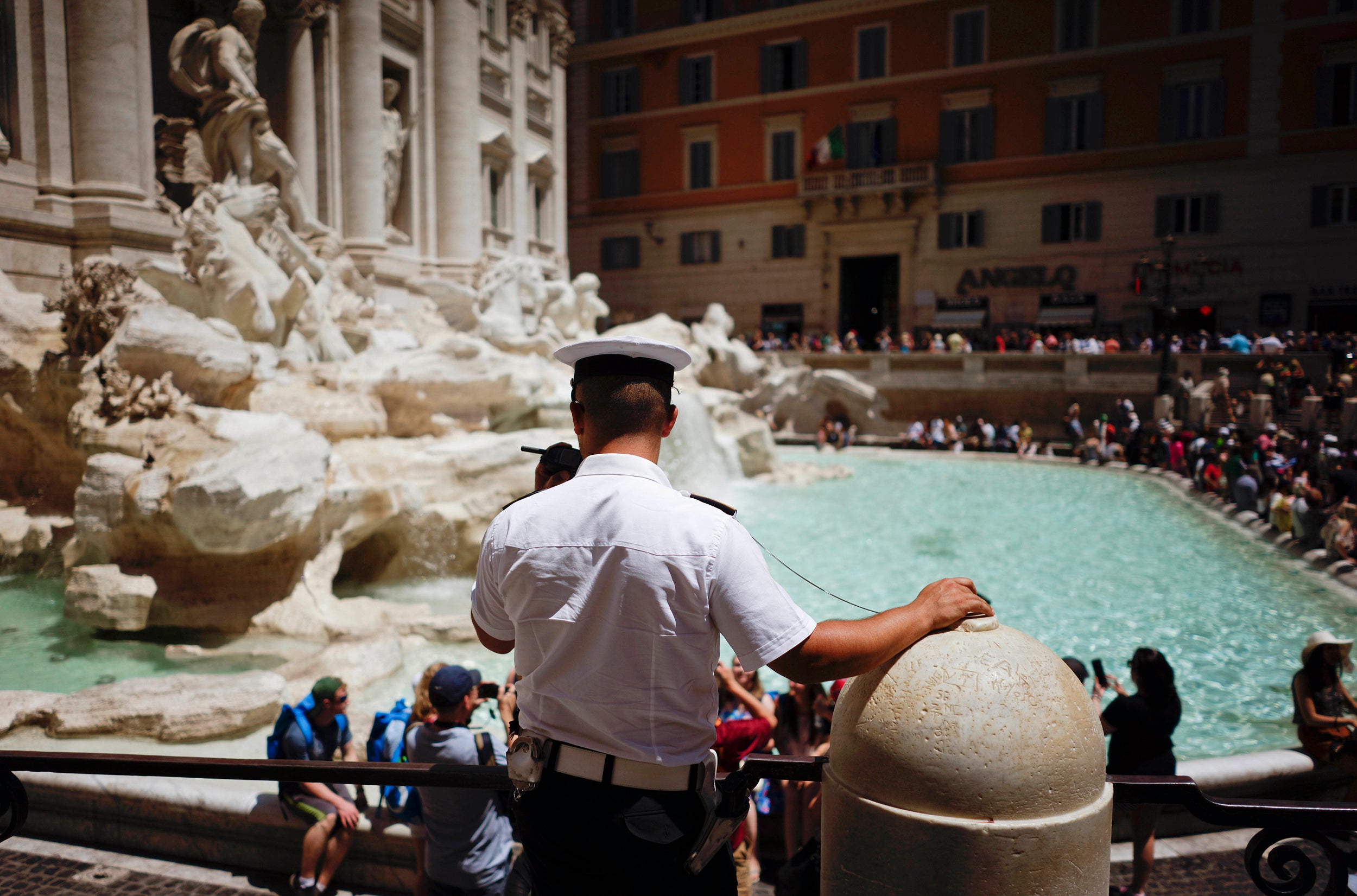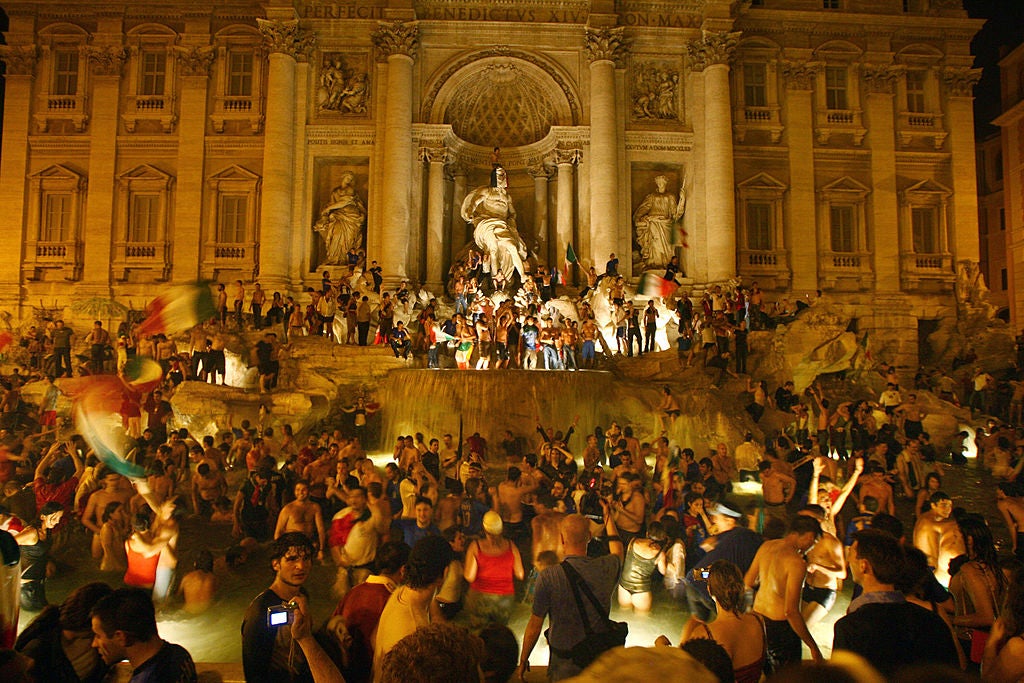No swimming! Rome braces for summer of tourists at its fountain
Police in the Eternal City have their work cut out preventing the ‘New Barbarians’ from making a splash at monuments such as the Trevi fountain. And these overenthusiastic visitors are discovering their dip in the water can be expensive as well as refreshing

Your support helps us to tell the story
From reproductive rights to climate change to Big Tech, The Independent is on the ground when the story is developing. Whether it's investigating the financials of Elon Musk's pro-Trump PAC or producing our latest documentary, 'The A Word', which shines a light on the American women fighting for reproductive rights, we know how important it is to parse out the facts from the messaging.
At such a critical moment in US history, we need reporters on the ground. Your donation allows us to keep sending journalists to speak to both sides of the story.
The Independent is trusted by Americans across the entire political spectrum. And unlike many other quality news outlets, we choose not to lock Americans out of our reporting and analysis with paywalls. We believe quality journalism should be available to everyone, paid for by those who can afford it.
Your support makes all the difference.On a sweltering Monday afternoon, a beautiful day for a swim, Mario Messina noticed some holidaymakers teetering dangerously close to the turquoise waters and sounded five short blasts of his whistle.
“Come down!” Messina said, with an elegant flip of the hand to a woman leaning over the ledge to test the water temperature. “Come down!”
Despite his Ray Bans, virtuosity with a whistle and sunny Sicilian disposition, Messina is not a seaside lifeguard but a Roman police officer in a pith helmet. He is entrusted to protect the Trevi fountain, one of the world’s most cherished and visited monuments, from the scourge of parched, overheated and advancing tourist armies. And now he has reinforcements.
Because summer is here.
Already, the warm weather has brought a menacing whiff of tourists behaving badly. For months, stiff fines failed to stop a fountain-bathing fad in a city blessed with and born of flowing water.
On 12 April, a man went skinny-dipping in the Trevi fountain, resulting in a viral web video and a fine of €500 (£439). (“I was here for the naked guy,” Messina said, adding that nudity carried a criminal complaint “because it was an obscene act”.)

That same month, a 30-year-old Spanish tourist waded into the fountain dressed in a long tunic, a German woman in her 60s took a morning dip, and two Danes received €900 fines for mistaking the fountain of Two Seas at Rome’s Piazza Venezia for a foot bath.
Then there was May. A 25-year-old Danish woman, perhaps with La Dolce Vita visions of Anita Ekberg sloshing in her head, took an evening swim in her nightgown. And two American women, according to Messina, went for a (previously unreported!) swim.
And June. A 30-year-old Malaysian man bathed nude in Gian Lorenzo Bernini’s baroque Four Rivers fountain in Piazza Navona and received a €450 fine. (“I was hot,” he reportedly explained to the police.)
The police also apprehended a Czech artist washing a dirty rag in the Piazza del Popolo’s Fontana dei Leoni (Fountain of the Lions). Soon after, they fined the British and Romanian parents of two children for allowing them to climb on the lions.
The “New Barbarians,” as some papers have taken to calling the tourists, are not limited to Rome. In Florence, officials have taken to hosing down the Duomo Cathedral and other sites to prevent loiterers from sitting and eating on the steps.
But it is Rome and its fountains that are in the eye of the selfie storm, prompting the city’s embattled mayor, Virginia Raggi, to issue an ordinance.
Until October, there are harsher fines for eating, drinking or sitting on the fountains, for washing animals or clothes in the fountain water or for throwing anything other than coins into the water of the Trevi fountain and 36 other fountains of artistic or historic significance around the city.
“It is unacceptable that someone uses them to go swimming or clean themselves. It’s a historic patrimony that we must safeguard,” Raggi said last week during what she called a surprise “inspection” of the situation at the Trevi fountain.
Raggi, accompanied by two aides, went unnoticed by the tourists in beachwear and at times had trouble squeezing through the crowd. She said that to a certain degree, the bathing phenomenon had always existed, but that with videos of nude fountain bathing spreading on social media, she felt “we simply must do something more. And that’s what we have done.”
Enemies of the mayor, a national figurehead of the list of Roman woes under her administration, including festering rubbish on the city pavements, unkempt parks that resemble wheat fields and traffic-clogged streets transformed into idling parking lots. When in degraded Rome, they argue, tourists will do as the degraded Romans.

But it is hard to pin the tourist nuisance on her. In 1999, Italy felt the need to pass a law to protect city monuments and banned wading in the fountains. In 2012, a previous mayor drafted an ordinance fining tourists as much as €500 for dripping ice cream, dropping crumbs and lunching on the monuments.
Many Romans remember the local folk hero known as D’Artagnan, who for decades waded into the fountain before dawn to fish for the coins that wishful tourists had tossed behind.
Still, Vittorio Avanzini, the publisher of Roman historical guides including The Fountains of Rome, insisted that throughout the city’s long history, “it’s never been like this”.
To combat the heated hordes, Dario Franceschini, the Italian culture minister, has floated the idea of limiting the number of tourists permitted to view blockbuster monuments at any one time.
“You can’t have 50,000 people at the Trevi fountain — there’s a maximum capacity. These are places to safeguard, fragile places,” Franceschini said.
He welcomed the explosion of tourists from China and other countries eager to visit Italy, but said that the huge numbers created new challenges and argued that new technology allowed for the automatic counting and regulation of the masses. “It’s absolutely necessary.”
As Raggi left the Trevi fountain to check out the situation at a renaissance fountain in Piazza d’Aracoeli at the foot of the Capitoline Hill, she refused to entertain the limited numbers idea.
“The monuments are for everyone,” she said. “And it’s fair that everyone who respects the rules can visit them, enjoy their beauty.”

What Raggi and Franceschini agree on, in the spirit of politicians everywhere, is that their police – including an undercover fountain squad – are doing a bang-up job on protecting the watery monuments.
On a recent afternoon, tourists’ arms flew in the air like slot machine levers to toss some of the more than €1m worth of coins that sink into the Trevi fountain every year.
Messina kept a watchful eye and blew his whistle at tourists climbing up the fountain’s edges. “They think it is a playground,” he said, attributing the rash of fountain abuse to social media, or “advertising for bad behaviour.”
He recalled a Turkish tourist about six months ago who climbed all the way up the sculpture of Neptune, who lords over the fountain.
But he confided that the worst offenders were three elderly local men who came every morning to sit for hours on a bench beside the fountain, their eyes trained up at the women walking above them in short skirts.
“Obsessives,” Messina said, shaking his head.
Even as Messina deftly enforced the law, he made sure not to detract from people revelling in their Roman holiday. He posed for pictures and instructed grateful tourists over which shoulder to properly toss their coin. (“Right hand over left shoulder, across you heart.”)
He said he appreciated the ordinance and its increased manpower, from two to now six officers on duty 24 hours a day, because “thousands of tourists are not easily controlled”.
He again whistled some stragglers off the fountain walls as one of his reinforcements, an eighth officer in a neon mesh vest, came on in relief.
“I’m here for the 5 o’clock shift,” she said. “Take a break.”
© New York Times
Join our commenting forum
Join thought-provoking conversations, follow other Independent readers and see their replies
0Comments